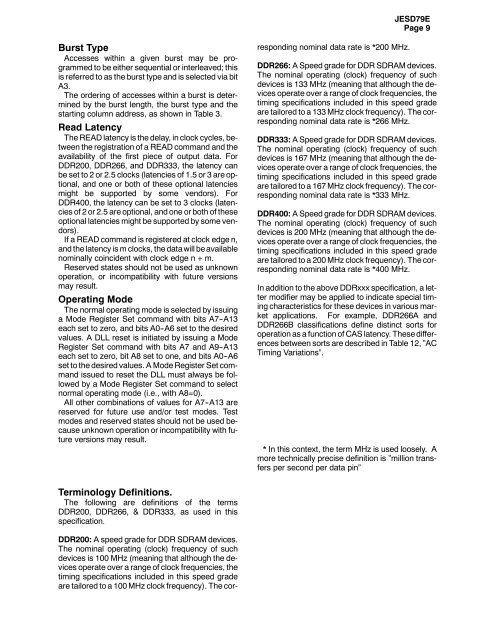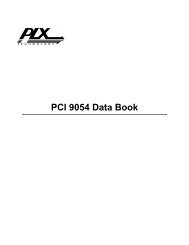Create successful ePaper yourself
Turn your PDF publications into a flip-book with our unique Google optimized e-Paper software.
JESD79E<br />
Page 9<br />
Burst Type<br />
Accesses within a given burst may be programmed<br />
to be either sequential or interleaved; this<br />
is referred to as the burst type and is selected via bit<br />
A3.<br />
The ordering of accesses within a burst is determined<br />
by the burst length, the burst type and the<br />
starting column address, as shown in Table 3.<br />
Read Latency<br />
The READ latency is the delay, in clock cycles, between<br />
the registration of a READ command and the<br />
availability of the first piece of output data. For<br />
DDR200, DDR266, and DDR333, the latency can<br />
be set to 2 or 2.5 clocks (latencies of 1.5 or 3 are optional,<br />
and one or both of these optional latencies<br />
might be supported by some vendors). For<br />
DDR400, the latency can be set to 3 clocks (latencies<br />
of 2 or 2.5 are optional, and one or both of these<br />
optional latencies might be supported by some vendors).<br />
If a READ command is registered at clock edge n,<br />
and the latency is m clocks, the data will be available<br />
nominally coincident with clock edge n + m.<br />
Reserved states should not be used as unknown<br />
operation, or incompatibility with future versions<br />
may result.<br />
Operating Mode<br />
The normal operating mode is selected by issuing<br />
a Mode Register Set command with bits A7--A13<br />
each set to zero, and bits A0--A6 set to the desired<br />
values. A DLL reset is initiated by issuing a Mode<br />
Register Set command with bits A7 and A9--A13<br />
each set to zero, bit A8 set to one, and bits A0--A6<br />
set to the desired values. A Mode Register Set command<br />
issued to reset the DLL must always be followed<br />
by a Mode Register Set command to select<br />
normal operating mode (i.e., with A8=0).<br />
All other combinations of values for A7--A13 are<br />
reserved for future use and/or test modes. Test<br />
modes and reserved states should not be used because<br />
unknown operation or incompatibility with future<br />
versions may result.<br />
DDR200: A speed grade for DDR SDRAM devices.<br />
The nominal operating (clock) frequency of such<br />
devices is 100 MHz (meaning that although the devices<br />
operate over a range of clock frequencies, the<br />
timing specifications included in this speed grade<br />
are tailored to a 100 MHz clock frequency). The corresponding<br />
nominal data rate is *200 MHz.<br />
DDR266: A Speed grade for DDR SDRAM devices.<br />
The nominal operating (clock) frequency of such<br />
devices is 133 MHz (meaning that although the devices<br />
operate over a range of clock frequencies, the<br />
timing specifications included in this speed grade<br />
are tailored to a 133 MHz clock frequency). The corresponding<br />
nominal data rate is *266 MHz.<br />
DDR333: A Speed grade for DDR SDRAM devices.<br />
The nominal operating (clock) frequency of such<br />
devices is 167 MHz (meaning that although the devices<br />
operate over a range of clock frequencies, the<br />
timing specifications included in this speed grade<br />
are tailored to a 167 MHz clock frequency). The corresponding<br />
nominal data rate is *333 MHz.<br />
DDR400: A Speed grade for DDR SDRAM devices.<br />
The nominal operating (clock) frequency of such<br />
devices is 200 MHz (meaning that although the devices<br />
operate over a range of clock frequencies, the<br />
timing specifications included in this speed grade<br />
are tailored to a 200 MHz clock frequency). The corresponding<br />
nominal data rate is *400 MHz.<br />
In addition to the above DDRxxx specification, a letter<br />
modifier may be applied to indicate special timing<br />
characteristics for these devices in various market<br />
applications. For example, DDR266A and<br />
DDR266B classifications define distinct sorts for<br />
operation as a function of CAS latency. These differences<br />
between sorts are described in Table 12, ”AC<br />
Timing Variations”.<br />
* In this context, the term MHz is used loosely. A<br />
more technically precise definition is ”million transfers<br />
per second per data pin”<br />
Terminology Definitions.<br />
The following are definitions of the terms<br />
DDR200, DDR266, & DDR333, as used in this<br />
specification.




